- A
- B
- C
- D
- E
- F
- G
- H
- J
- K
- L
- M
- N
- O
- P
- R
- S
- T
- V
- W
Royal Victoria Gallery (McKechnie Section 1)
See also Section Six
A gallery (not previously recorded under this name) managed by three members of a family named Frith, at least two of whom were producing silhouettes (signed 'Frith') before the family concern was named the Royal Victoria Gallery. Though the exact date at which they gave their concern this name is unknown this would not have been until after they had taken a silhouette of the Queen (and, therefore, must have been after 1837). For convenience, all work produced by the Friths is discussed in this entry, whether produced before the founding of the gallery or not.
The name Frith was recorded (spelt 'Firth') by Jackson (The History of Silhouettes); later, in her Dictionary, she refers to 'Frederick Frith'. Strickland listed Frith, without a Christian name, as an artist who visited Cork and Limerick in c. 1840, 'moving from place to place with other practitioners of his art'. He also records that an artist named Frith was in Scotland in c. 1830, and produced there many silhouette portraits, particularly in full-length, as well as 'caricatures'. In The Art of Silhouette Coke refers to a lavishly gilded silhouette signed 'F. Frith, Dover, Kent'. This appears to have been dated 1825, but Coke was not sure whether or not the 2 in this date had been altered, nor (if it had been) does he make it clear whether it had been altered from an earlier or a later decade. This reference has led later writers to assume that Frith was a native of Dover; no one named F. Frith, however, is listed in any contemporary rating or jury registers of this town. (I should add here that none of the silhouette artists named Frith should be confused with the better known William Powell Frith (1819-1909), the painter, who was in fact a pupil at Cliff House School, St Margaret's, at Cliffe, near Dover, 1829-35).
In his notebook, Woodiwiss states that he saw a fine full-length silhouette of an officer, painted in full detail, clearly signed 'H. A. Frith, 1841'. A search by Mr Percy Higgs of the records of deaths at Somerset House for the years 1841-1910, however, yielded no mention of an H. A. Frith in the relevant age group.
It is clear, then, that each of the authorities mentioned above was discussing one or other of two silhouette artists named Frith, but without establishing a link between them. However, on 26 April 1971 at Sotheby and Company, London, there were sold two bust-length silhouettes of a man and a woman, each inscribed on the back 'Taken by Mr. Frith on 3rd. of January, 1843, at Limerick'. During the years 1840-42, three advertisements had appeared in the Limerick Chronicle. The existence of these advertisements proves that F. and H. A. Frith were brothers, and that their father was a miniaturist and portrait painter who also sometimes helped with the work at the Royal Victoria Gallery. Another advertisement, however, is known, which (though undated by Jackson, who quotes it in her Dictionary), was probably published years (possibly nearly twenty years) before the three advertisements in the Limerick Chronicle. It appeared in a Tunbridge Wells newspaper, probably in the 1820s:
The Nobility and Gentry and Inhabitants of Tunbridge Wells are respectfully informed that Master Frith will remain but one week longer in this town. Those ladies and gentlemen who have not yet completed their family sets, are requested to make early application.
That extraordinary talented youth Master Frith who has been the astonishment of all lovers of the fine arts, will exercise his ingenious and interesting profession for one week longer in this town, next door to the Ladies Bazaar. &c.
A plain bust 1s., duplicate of ditto, 6d.
A bust in gold bronze or shaded with drapery, 2s. 6d. Whole length figure in plain black. 2s. 6d.
Ditto, duplicate of ditto, 1s. 6d.
Ditto, very highly finished, 2s. 6d.
The much admired colour profiles, 10s. 6d.
Whole length figure in bronze or shaded drapery developing every characteristic peculiarity of
Hair, Dress, &c. 5s. 6d.
Though we cannot be certain, it seems likely that 'Master Frith' (born perhaps c. 1810-15) was F. Frith, who, as Coke records, took a silhouette in Dover (not very far from Tunbridge Wells) in 1825: hence the suggested date of this advertisement. Moreover, the earliest of the advertisements in the Limerick Chronicle (27 June 1840) states that F. Frith had now been
joined at the gallery by H. A. Frith (his brother, probably younger than him) as well as by the brothers' father. The text of the advertisement reads as follows:
ROYAL VICTORIA GALLERY 122, George's Street, Limerick.
Mr. F. Frith, Artist in Papyrotomia, and Proprietor of the above Gallery, takes this opportunity of thanking the Nobility, Gentry, and his friends generally, for the immense patronage he has been favoured with during his short residence in this City: and triumphantly refers to the many Thousand Likenesses he has already taken here, as a favourable omen that he shall still continue to enjoy their countenance and support during his
Now Very Short Stay
He likewise begs to add, that Mr. Frith, Senr., Portrait and Miniature Painter, has just arrived from London, where his vigorous Portraits have, for many years, been duly appreciated, and at first produced quite a sensation, from the fidelity of their resemblance, truth of their character, and spirit of their finish. Mr. F. FRITH has received an accession of Talent, by the arrival of his Brother, Mr. HENRY ALBERT FRITH, from Regent- Street, London, in consequence of the immense press of Business which otherwise could not have been executed, who has brought with him a great number of Grotesque, as well as interesting London Characters, taken by him while in Regent Street; so that the VICTORIA GALLERY may now be pronounced the most scientific, as well as the first Exhibition of the kind in the World. The few Characters in the Shop-Window are merely an announcement of the GALLERY, on the First Floor.
Terms for Likenesses may be seen at the Door: as, also, on the posting and distributing bills.
Portraits of every description copied, or reduced to Miniature Size; Oil Paintings cleaned and varnished.
ROYAL VICTORIA GALLERY,
122, GEORGE'S STREET, LIMERICK.
June 27
It is evident from this advertisement that F. Frith began his tour of Ireland in the south west (which may have seen few touring silhouette artists since Edouart had spent some months there in 1834). As Frith refers to 'many Thousand Likenesses', it might be thought that by this date he had already been in Limerick for some months. In view of his continuing success, both his brother, Henry Albert, and his father, 'Mr. Frith, Senr.', were summoned from London to cope with the large demand for silhouettes. The father's identity has now been established. In Mrs Sue Pinker's collection there is a profile miniature in colour of an officer signed 'J. Frith', dated 1841, and bearing the address of the gallery at 122 George Street, Limerick. This must have been John Frith, who exhibited at the Academy in 1819, from Croydon (Graves lists two portraits). Foskett considers his work to be of little merit, and records that the Academy exhibits were miniatures of a Mrs Henson and one C. Armstrong. She records another address at 7 St Martin's Court, London, and tells us that in 1834 Frith was working at Cornhill, London. It seems, therefore, that the Friths were a London family. A John Frith is listed as 'artist' in two successive issues of Robson's Directory in 1839, at 93 Strand and, secondly, 63 Tottenham Court Road. This could well be the John Frith with whom we are concerned. No John Frith is listed at either of the addresses just mentioned in Census Day returns for 1841, but this is consistent with the evidence that the Friths were in Limerick at the time. From the same advertisement we gather that H. A. Frith had been working on his own in Regent Street, earlier in 1840, before he and his father were asked to go to Ireland. The success in Limerick must have continued, for a second advertisement in the Limerick Chronicle (9 September 1840) makes it clear that at least one member of the family (H. A. Frith) was still working in the town, on the eve of departure:
PUBLIC ANNOUNCEMENT
MYSTERIOUS ART
ROYAL VICTORIA GALLERY
122, George's Street, LIMERICK
WILL FINALLY CLOSE IN ONE WEEK
LIKENESSES FROM ONE SHILLING
HENRY ALBERT FRITH, cannot feel satisfied in leaving this city, without expressing his gratitude to the numerous friends who have so kindly supported him during his sojourn in this place. He is now about leaving and bids his grateful farewell to the generous and beautiful Ladies, as well as to the high-spirited and brave Irishmen that abound in this City, assuring them that when he returns to his own country, the pleasing recollection of Irish habits, hospitality and goodness, will always be to him a great source of gratification.
122, GEORGE-STREET, LIMERICK
September 9.
Unless this statement of the intention to leave was made with a view to stimulating business, we can assume that H. A. Frith left Limerick in September 1840. It is not known whether the gallery, or any of the Friths, stayed in Ireland during 1841. Both the Frith brothers were evidently at work during that year. Mr T. E. F. Sainsbury owns a silhouette dated 1841, signed in what was probably F. Frith's manner, and the silhouette of an officer by H. A. Frith, recorded in his note book by Woodiwiss, also dates from this year. At least two members of the family, however, were back in Limerick by the end of 1842: one of the sons (we do not know which one) and John Frith, as a third advertisement in the Limerick Chronicle (24 December 1842) bears out:
ELEGANT CHRISTMAS PRESENTS
ROYAL VICTORIA GALLERY
From Regent Street, London 122 George's Street, Limerick
Papryotornia
MR. FRITH
PAPRYOTOMIST to His Late as well as to her present Most Gracious Majesty, and to whom most of the brilliant Court of the United Kingdom have sat for Their Likenesses. Has the honour of announcing to the Nobility and Gentry of Limerick, his second and final visit to this ancient and wealthy City. And flatters himself that the exercise of the same Talents will secure to him the same degree of patronage with which he was formerly honoured.
Extraordinary Likenesses taken in one minute. Whole length figures taken in any position: Infants in Their Mothers' or Nurses' arms: Children at Their favourite pursuits or studies in Single Figures or Family Groups: Aged Persons, averse to tedious Sittings, are taken in an instant or unawares — a mere glance being sufficient to secure the most spirited resemblance.
Officers in Full or Undress Uniform, Mounted, or on Foot. Horses, Dogs, &c., &c. In short, every object in Nature and Art is pourtrayed so instantaneously by Mr. FRITH's Talismanic Scissors, that it has been considered by some to be almost miraculous!
TERMS:
Bust, plain black 1s. Od.
Ditto in Bronze 3s. 6d.
Full-Length in Black 3s. 6d.
Full-Length, in Bronze 7s. 6d.
Ditto, highly finished 10s. 6d
Ditto, in uniform 12s. 6d.
Two highly finished, equestrian figures of Her Majesty and Prince Albert, as well as numerous specimens of well- known Characters, may be seen at the Gallery.
Mr. FRITH is happy to announce the arrival of his Father, whose Talents as a Portrait and Miniature Painter are too well known to need
Comment and who will undertake a limited number of Likenesses during his short stay.
N.B. Visitors can be accommodated at Their own Residence, when the order exceeds ONE GUINEA.
December 24
Both the Frith brothers appear to have been capable of the wide range of silhouette work offered in this advertisement. The phrase 'from Regent Street, London' suggests that 'Mr Frith', here, was H. A. Frith.
Whichever brother issued this advertisement had certainly been in practice before Queen Victoria's accession in 1837, since the reference to 'Papryotomist to His Late as well as to Her Present Majesty' includes William IV as well as Queen Victoria. As it was H. A. Frith who praised the people of Limerick so warmly in the advertisement issued in September 1840, it seems likely that he was indeed the author of this announcement. If so, it would have been he who stayed in Limerick over Christmas and, in January, took the pair of profiles mentioned earlier.
H. A. Frith seems to have continued working into the 1850s: examples of the caricature work which I think is his, dating from 1848, 1851 and (an example in my collection) 1854 have been seen. I have illustrated one example dated 1843, which appears from the style of the signature to be by F. Frith. Nothing, however, is known of the career of John Frith after 24 December 1842.
The dates of death of the three Friths are not known. At least nine F. Friths are recorded at Somerset House as having died during the years 1837-90. H. A. Frith's death is not recorded there at all (possibly he died outside England and Wales) and I have found no record of John Frith's death.
Two references to the Friths by previous authorities should be mentioned here. Jackson (Dictionary) mentions that `landscapes done in Wales' by F. Frith were exhibited at the Royal Academy 1809-1828, but no record of such exhibits, either at the Academy or at the British institution, can now be traced. Jackson adds that 'he also worked in Canada', but there is no corroborative evidence. (I have seen no work by the Friths dated 1846; it is just possible that one of the brothers was in Canada during that year.) Benezit records F. Frith as 'a painter of silhouettes, and a caricaturist working in Scotland and Ireland in 1825', and states that a lithographed portrait of Wellington was produced by Frith. Possibly this lithograph was not an original production of F. Frith, but engraved after one of his silhouettes by another artist. On the evidence of the style of the signatures, I would ascribe the caricature work to H. A. Frith.
When considering the work produced by the Royal Victoria Gallery we are dealing not only with the work of three members of the Frith family, but also possibly with that of assistants whose names are now unknown. The quality of the painting on the gallery's work, with the possible exception of the later silhouettes of caricature type, is very high, the bronzing, in particular, being extremely skilful. Unless an initial was prefixed to the usual signature, 'Frith' (and it rarely was), silhouettes can only be ascribed to one member of the family by conjecture, style of signature, date and by such evidence as I give below of each of the Friths' style and technical capacities. I will consider John, F. and H. A. Frith in turn, and finally make some comments on the gallery's work in general and on a few silhouettes of special interest.
John Frith is described in the gallery's advertisements as 'Portrait and Miniature Painter'. Examples of his work in colour have already been mentioned. It seems unlikely that, with his accomplishment as a painter, he would have undertaken any of the basic cutting of the profiles produced by the gallery. He may, however, have been responsible for the 'much admired colour profiles, 10s. 6d' mentioned in the Tunbridge Wells advertisement, and it was probably he who implemented the offer, contained in the advertisement in the Limerick Chronicle (27 June 1840), of 'portraits of every description copied, or reduced to Miniature Size; Oil Paintings cleaned and varnished'. In the third advertisement published in the Limerick Chronicle (24 December 1842) we are told that John Frith had arrived and 'would undertake a limited number of Likenesses during his stay'. As no work in colour was advertised on this date, it is possible that John Frith may have painted the detail (especially, perhaps, on the 'highly finished' examples) of silhouettes already cut by the son who issued the advertisement. Until a silhouette signed 'J. Frith' is found, it is impossible to say whether or not this was so.
One silhouette signed 'F. Frith, 1835' is illustrated. Another, in the Christie collection, signed F. Frith, Papryotemmist' [sic], dates from the early 1830s, and a signature, with the name 'Frith' painted in the same style, is illustrated in this Section. Although the style of these two silhouettes is very similar to that of those considered to be by H. A. Frith, the background is of a more finished quality. In outdoor scenes by both brothers, the foregrounds are dominated by foliage in nearly every case; this foliage is painted in a more finished style on examples assignable to F. Frith than on those assignable to his brother. In indoor scenes by the Friths the flooring consists of a design of ovals, which do not touch each other and are given substance by a rough line in the centre of each. I have seen one unsigned full-length silhouette, possibly by F. Frith, which is well bronzed and is set against an outdoor background painted in full colour. I have not seen a bust-length silhouette, either plain black or bronzed, that appears to be by F. Frith, and the preceding remarks apply only to full- length work.
On the examples attributable to F. Frith because of the style of signature, bronzing was achieved with a mixture of yellow water-colour (probably yellow ochre pigment) with gold paint, used for extreme highlighting. These examples show more gold paint than those considered to be by H. A. Frith. Chinese white was also used on 'highly finished' work, such as the illustrated silhouette of Major Raich, but, since both brothers produced this kind of work with equal skill, it is only the style of signature that leads one to attribute this piece to F. Frith. Dates, if given, would help in the matter of ascription. If the example formerly owned by Coke (referred to above) was indeed dated 1825, then F. Frith must have been working as early as this. The latest of the illustrated examples assigned to this artist is dated 1843.
The style of signature seen on work attributable to H. A. Frith is also illustrated. I have seen both black and bronzed work signed in this style, as well as the caricature silhouettes, of which all the examples that I have seen bear dates in the late 1840s or 1850s. As I have implied above, the backgrounds of full-length silhouettes attributable to H. A. Frith are less finished than those on examples assignable to his elder brother. Distant hills are shown on some of the outdoor backgrounds. If it was H. A. Frith who issued the advertisement in the Limerick Chronicle in December 1842, then the wording tells us that he was in practice (as Papryotomist to His Late as well as to her present Majesty') before 1837. One illustrated example, dating apparently from the mid-1830s, can be assigned to him. The latest example signed in his style is dated 1854, and is of the caricature type. It shows the sitter (General Peel, brother of Sir Robert Peel) in full-length. The clothing is painted in colour, and the face is rendered in a curious pink pigment mixed with black. Other examples which have been seen show figures (again in full-length and in some cases as high as twelve inches) with bright yellow faces, and clothing roughly painted in part colour. These examples include some well known people of the time, represented in grotesque attitudes. All are of late date and are signed in the style of H. A. Frith. On the most typical examples of H. A. Frith's better work, bronzing is often achieved by the use of yellow ochre pigment only, without any gold paint. All the illustrated examples which are probably H. A. Frith's work are painted in this way. One all-black silhouette of a family group is illustrated. This, signed in H. A. Frith's style, is inferior to his bronzed work. The seaside background is not well painted, and the plain cutting is mediocre. The boys' collars are left white, and are not cut with the rest of the silhouette; a little rough shading was added to give them shape.
One feature common to most of the full-length male figures produced by the Royal Victoria Gallery, which will be apparent from the illustrations, is the stance in which the figures are shown. In nearly every case men are shown standing with their feet apart, with the far leg bent at the knee. One example is the figure of Lord Melbourne, on a silhouette on which he is shown with Queen Victoria. This silhouette was first illustrated by Jackson (The History of Silhouettes) with the caption, 'Probably cut by Atkinson of Windsor, and pencilled with gold.' (Jackson had in any case reversed the relationship of George Atkinson, a painter of silhouettes, and his son F. Atkinson, a cutter; qq.v.) Although I have not examined this example, which is apparently unsigned, it seems to me to be unquestionably the work of one of the Friths (probably H. A. Frith); the background of distant hills, the foliage in the foreground and the poses of the figures are all typical. This silhouette has been illustrated by later writers who have repeated Jackson's almost certainly mistaken attribution. Since the Friths named their gallery after Queen Victoria and tell us in the Limerick advertisement of December 1842 that the artist responsible for this announcement had taken a portrait of 'Her present Most Gracious Majesty’, it is very likely that this portrait was taken from life. The same may be true of the portrait of the Queen, said to be by F. Frith, illustrated on the dust cover of Jackson's Dictionary.
Though more extant silhouettes produced by the gallery are full-length, some bust-length examples are known. One is illustrated, and two others, in the same style, are those sold by Sotheby and Company, London, on 26 April, 1971. All three are very well painted, entirely bronzed in yellow pigment, without the use of gold, and are probably H. A. Frith's work. The illustrated example is almost half length: the bust-line terminates in a single curved arc, and some rough brown shading was added at the sides, giving it a crescent- shaped outline. Although the piece is unsigned, the unique bust-line finish, as well as the quality of the yellow ochre bronzing, unquestionably indicate the same provenance as that of the two silhouettes sold by Sotheby and Company.
I have seen no signed black bust-length work by the Friths. Unsigned examples would be difficult to identify, since the basic cutting of silhouettes by the Friths show few distinctive features. It seems, from their advertisements, that the gallery's work was cut freehand.
Silhouettes produced by the Royal Victoria Gallery are usually framed in maple, but the black silhouette of the family group is in a deal frame stained black. Examples have also been seen in black frames, with the profile surrounded with a plain gold oval line in verre églomisé. The bust-length silhouettes sold by Sotheby and Company, referred to above, were framed in carved leafed giltwood.
Apart from their occasional use, before 1837, of part of an advertisement pasted on to the back of a frame (and only the advertisement from the Tunbridge Wells newspaper is recorded as having been used in this way) the Friths used a painted inscription on the front of their silhouettes, shown in the background near the base. This gives the name 'Frith', with or without a date. Some early examples show 'F. Frith'. On later work, showing merely 'Frith', the name is painted in two entirely different styles (both illustrated). One, similar to the 'Frith' in signatures reading 'F. Frith', presumably indicates F. Frith's work. The other, seen on caricature examples of late date and on bronzed full-length work, must indicate H. A. Filth's work: this is further borne out by the poorer quality of background painting, already mentioned, which is seen on silhouettes inscribed as in the second illustrated example. The two silhouettes sold by Sotheby and Company bore in ink on the back the inscription already quoted: 'Taken by Mr. Frith on 3rd. January 1843 at Limerick.'
Ills. 140, 222, 259, 567-578., 638, 639
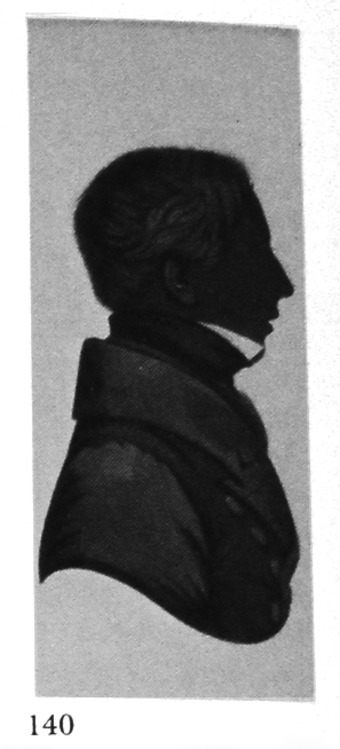
140
The Reverend Perkins, Junior, J. P.
Silhouette by John Field, c. 1835.
costume dating poitns
The hair, cut close at the back, with some signs of a side parting on the left.
The dark cravat of the 1830s, of the mail-coach type.
This is probably the top of a double-breasted frock-coat, for the tail-coat of the time had a collar higher at the back than this. There is still some gathering at the shoulders.
The Reverend Perkins, Junior, J. P.
Silhouette by John Field, c. 1835.
costume dating poitns
The hair, cut close at the back, with some signs of a side parting on the left.
The dark cravat of the 1830s, of the mail-coach type.
This is probably the top of a double-breasted frock-coat, for the tail-coat of the time had a collar higher at the back than this. There is still some gathering at the shoulders.
Author’s collection
Chapter 7
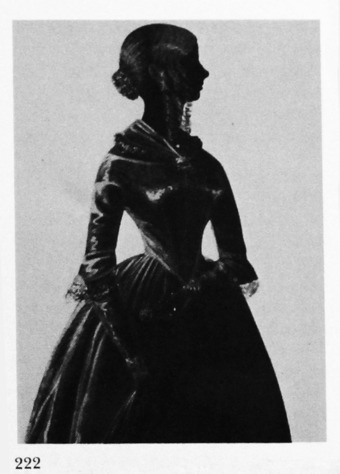
222
Unknown young woman. Detail of a group silhouette, possibly by H. . Frith; probably c. 1845.
The hair, dressed in the second style described in the text under ‘ 1840-50’.
The pèlerine, narrower than in the 1830s, made of transparent material and secured in front with a brooch.
The bodice, with the Gothic dip in the front made to cover the top of the arm. The typical pinched-in waist of the 1840s can be seen.
The sleeve of the dress (of type 4, as described in the text under ‘1840-50’), worn with engageantes.
The sitter carries a large handkerchief, and is probably dressed for the afternoon.
Unknown young woman. Detail of a group silhouette, possibly by H. . Frith; probably c. 1845.
costume dating poitns
The hair, dressed in the second style described in the text under ‘ 1840-50’.
The pèlerine, narrower than in the 1830s, made of transparent material and secured in front with a brooch.
The bodice, with the Gothic dip in the front made to cover the top of the arm. The typical pinched-in waist of the 1840s can be seen.
The sleeve of the dress (of type 4, as described in the text under ‘1840-50’), worn with engageantes.
The sitter carries a large handkerchief, and is probably dressed for the afternoon.
Author’s collection
Chapter 9
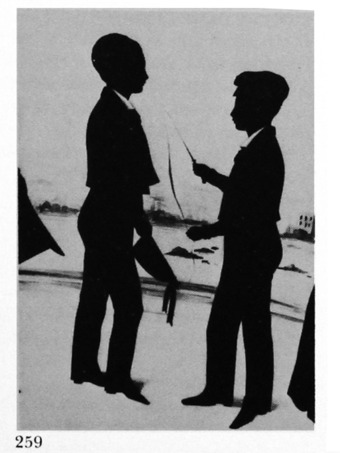
259
Two unknown boys (aged eleven to thirteen). Detail from a group silhouette (signed ‘Frith 1848’).
The fairly short hair (no parting is visible on this plain slhouette).
The two types of cap, both typical of the decade.
The white turn-down collar, only just showing over the lapel of each boy’s jacket.
The Eton suit.
The trousers are worn with boots (or possibly half-boots), which are fashionably square-toed.
Two unknown boys (aged eleven to thirteen). Detail from a group silhouette (signed ‘Frith 1848’).
costume dating poitns
The fairly short hair (no parting is visible on this plain slhouette).
The two types of cap, both typical of the decade.
The white turn-down collar, only just showing over the lapel of each boy’s jacket.
The Eton suit.
The trousers are worn with boots (or possibly half-boots), which are fashionably square-toed.
Author’s collection
SECTION ONE
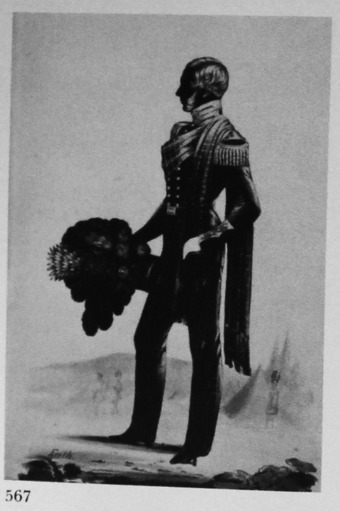
567
Major William Alexander Raich, 79th Cameron Highlanders
Cut silhouette
Early 1830s
10½ x 7½in./267 x 191mm.
Probably by F. Frith. The sitter, who was promoted major in 1815, carried his regiment’s colours at the Battle of Waterloo. He died in 1843.
Major William Alexander Raich, 79th Cameron Highlanders
Cut silhouette
Early 1830s
10½ x 7½in./267 x 191mm.
Probably by F. Frith. The sitter, who was promoted major in 1815, carried his regiment’s colours at the Battle of Waterloo. He died in 1843.
J. A. Pollak collection

568
Unknown woman
Cut silhouette, with detail painted in gold
1835
8 x 5in./204 x 128mm.
Signed ‘F. Frith, 1835’.
Unknown woman
Cut silhouette, with detail painted in gold
1835
8 x 5in./204 x 128mm.
Signed ‘F. Frith, 1835’.
Crown Copyright. Victoria and Albert Museum, No. E2266-1938
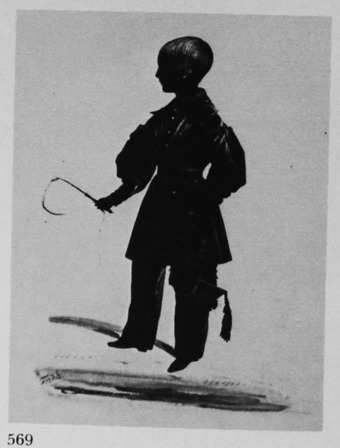
569
Unknown boy
Cut silhouette
Mid-1830s
10 x 7in./254 x 178mm.
Frame: maple
Unknown boy
Cut silhouette
Mid-1830s
10 x 7in./254 x 178mm.
Frame: maple
Probably an early example by H. A. Frith.
P. G. Higgs collection
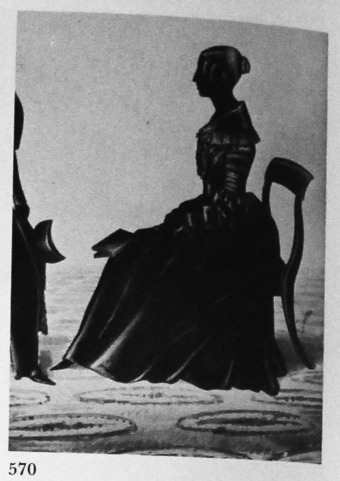
570
Figure from a group of two
Detail of cut silhouette, painted partly in gold
1841
Size of whole silhouette: 11 x 8½in/280 x 216mm.
Figure from a group of two
Detail of cut silhouette, painted partly in gold
1841
Size of whole silhouette: 11 x 8½in/280 x 216mm.
Signed ‘Frith, 1841’. Probably by F. Frith.
T. E. F. Sainsbury collection
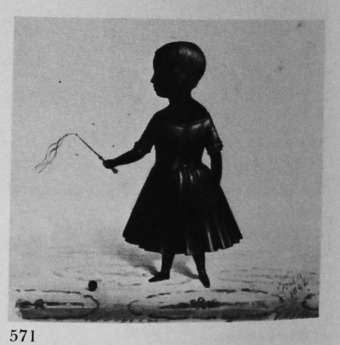
571
Unknown boy
Cut silhouette, with detail painted in gold
1843
11 x 8½in/280 x 216mm.
Frame: mahogany
Signed ‘Frith, 1843’. By H. A. Frith.
Unknown boy
Cut silhouette, with detail painted in gold
1843
11 x 8½in/280 x 216mm.
Frame: mahogany
Signed ‘Frith, 1843’. By H. A. Frith.
In private possession
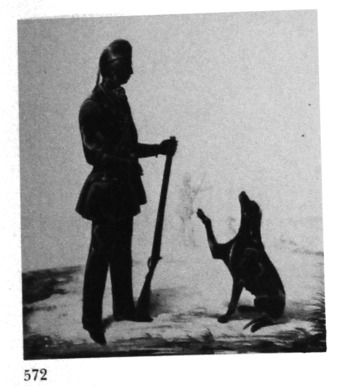
572
Shooting scene
Cut silhouette, with painted background and detail painted in gold
1843
10 x 8in./254 x 204mm.
Frame: maple
Shooting scene
Cut silhouette, with painted background and detail painted in gold
1843
10 x 8in./254 x 204mm.
Frame: maple
Signed ‘Frith, 1843’. Possibly by F. Frith; the foliage in the foreground is typical of his work.
R. Kilner collection
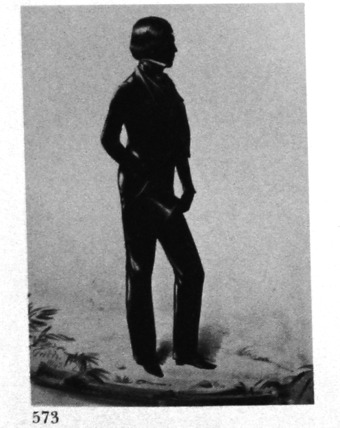
573
Graham Gowan
Cut silhouette
1843
8 x 5in./204 x 128mm.
Graham Gowan
Cut silhouette
1843
8 x 5in./204 x 128mm.
Probably by H. A. Frith, to judge from the style of the signature (‘Firth, 1843’).
Crown Copyright. Victoria and Albert Museum, No. E907-1954
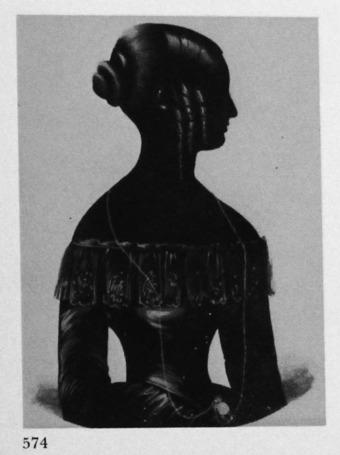
574
Unknown woman
Cut silhouette, bronzed in yellow-ochre
? 1843
3¾ x 3in./96 x 77mm.
Frame: giltwood
Unknown woman
Cut silhouette, bronzed in yellow-ochre
? 1843
3¾ x 3in./96 x 77mm.
Frame: giltwood
Probably by H. A. Frith. This silhouette is very similar in style to others inscribed as having been taken by ‘Mr Frith’ in Limerick in 1843.
Author’s collection
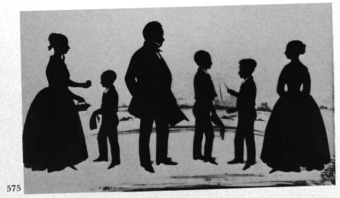
575
Family group
Cut silhouette, with painted background
1848
14 x 21in./365 x 534mm.
Frame: deal, stained black
The painting of the background is inferior to that of silhouettes ascribed to F. Frith.
Family group
Cut silhouette, with painted background
1848
14 x 21in./365 x 534mm.
Frame: deal, stained black
By H. A. Frith. Signed ‘Frith, 1848’.
The painting of the background is inferior to that of silhouettes ascribed to F. Frith.
Author’s collection
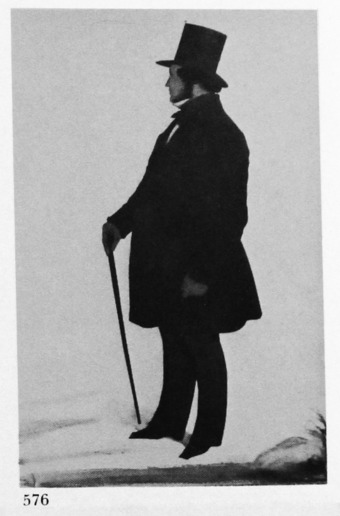
576
General Jonathan Peel
Cut silhouette
1854
9¾ x 7½in./248 x 191mm.
Frame: maple
This is an example of the artist’s work of caricature type. The sitter was the brother of Sir Robert Peel.
General Jonathan Peel
Cut silhouette
1854
9¾ x 7½in./248 x 191mm.
Frame: maple
By H. A. Frith. Signed ‘Frith 1854’.
This is an example of the artist’s work of caricature type. The sitter was the brother of Sir Robert Peel.
Author’s collection

577
Signature of F. Frith, from a silhouette (570) by the Royal Victoria Gallery.
Signature of F. Frith, from a silhouette (570) by the Royal Victoria Gallery.
T. E. F. Sainsbury collection
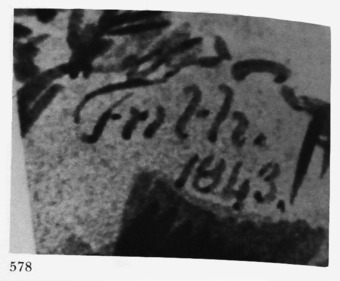
578
Signature of H. A. Frith, from a silhouette (573) by the Royal Victoria Gallery.
Signature of H. A. Frith, from a silhouette (573) by the Royal Victoria Gallery.
Crown Copyright. Victoria and Albert Museum, No. E907-1954
DETAIL

638
Detail from a silhouette of a man by H. A. Frith, showing the sitter’s trousers and (probably) elastic-sided half-boots. (576)
Detail from a silhouette of a man by H. A. Frith, showing the sitter’s trousers and (probably) elastic-sided half-boots. (576)
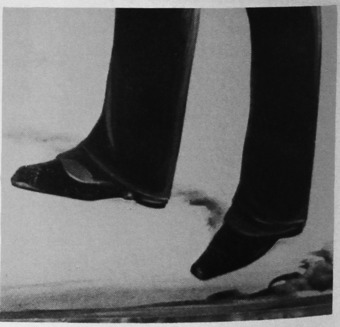
639
Detail from a silhouette of a man by H. A. Frith, showing the sitter’s trousers, spats and half-boots (embellished with yellow paint). (148)
Detail from a silhouette of a man by H. A. Frith, showing the sitter’s trousers, spats and half-boots (embellished with yellow paint). (148)
